ВУЗ: Не указан
Категория: Не указан
Дисциплина: Не указана
Добавлен: 01.04.2021
Просмотров: 1558
Скачиваний: 7
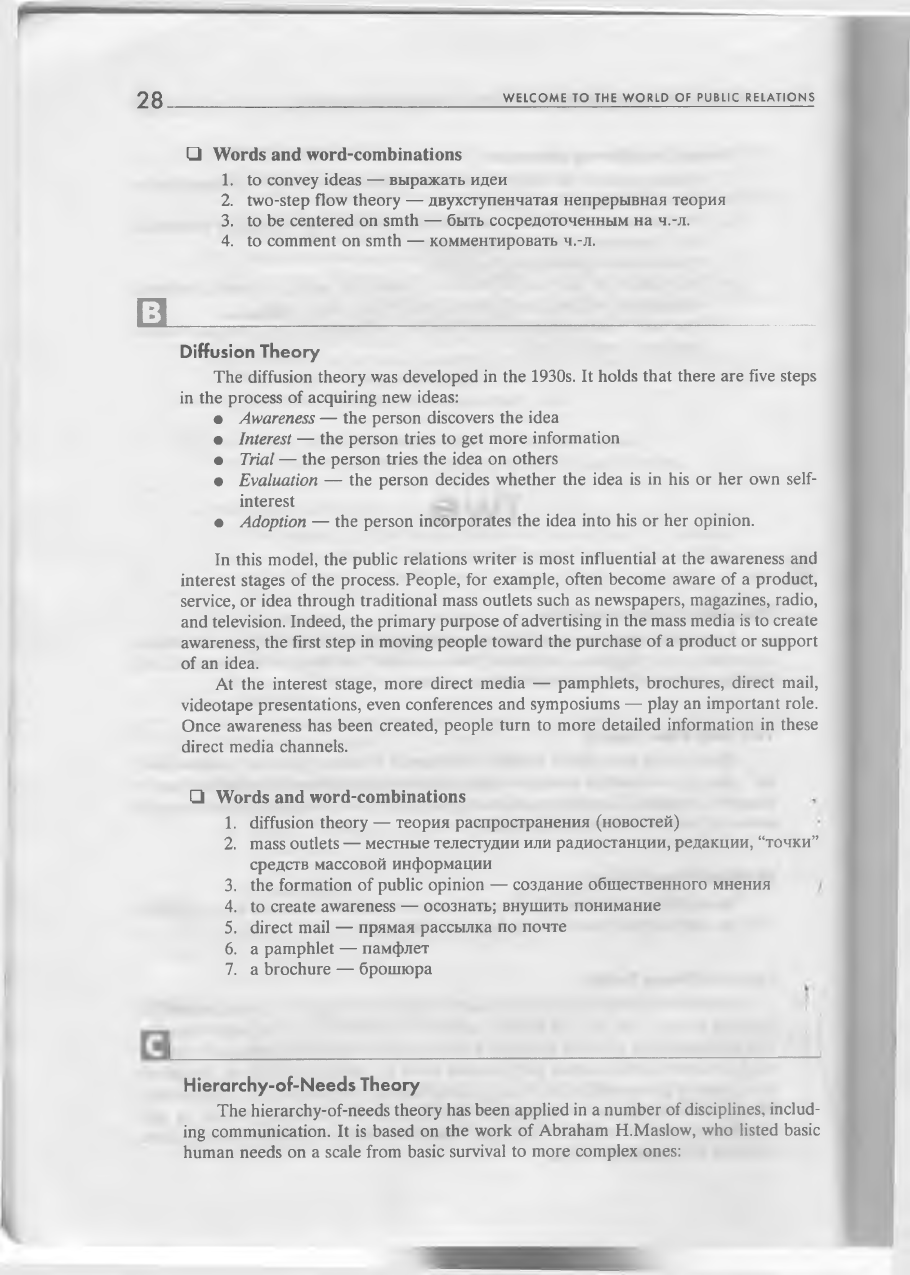
28
W E L C O M E T O T H E W O R L D O F P U B L I C R E L A T I O N S
□ Words and word-combinations
1. to convey ideas — выражать идеи
2. two-step flow theory — двухступенчатая непрерывная теория
3. to be centered on smth — быть сосредоточенным на ч.-л.
4. to comment on smth — комментировать ч.-л.
И
__________
Diffusion Theory
The diffusion theory was developed in the 1930s. It holds that there are five steps
in the process of acquiring new ideas:
•
Awareness
— the person discovers the idea
•
Interest
— the person tries to get more information
•
Trial
— the person tries the idea on others
•
Evaluation
— the person decides whether the idea is in his or her own self-
interest
•
Adoption
— the person incorporates the idea into his or her opinion.
In this model, the public relations writer is most influential at the awareness and
interest stages of the process. People, for example, often become aware of a product,
service, or idea through traditional mass outlets such as newspapers, magazines, radio,
and television. Indeed, the primary purpose of advertising in the mass media is to create
awareness, the first step in moving people toward the purchase of a product or support
of an idea.
At the interest stage, more direct media — pamphlets, brochures, direct mail,
videotape presentations, even conferences and symposiums — play an important role.
Once awareness has been created, people turn to more detailed information in these
direct media channels.
□ Words and word-combinations
1. diffusion theory — теория распространения (новостей)
2. mass outlets — местные телестудии или радиостанции, редакции, “точки”
средств массовой информации
3. the formation of public opinion — создание общественного мнения
4. to create awareness — осознать; внушить понимание
5. direct mail — прямая рассылка по почте
6. a pamphlet — памфлет
7. a brochure — брошюра
Hierarchy-of-Needs Theory
The hierarchy-of-needs theory has been applied in a number of disciplines, includ
ing communication. It is based on the work of Abraham H.Maslow, who listed basic
human needs on a scale from basic survival to more complex ones:
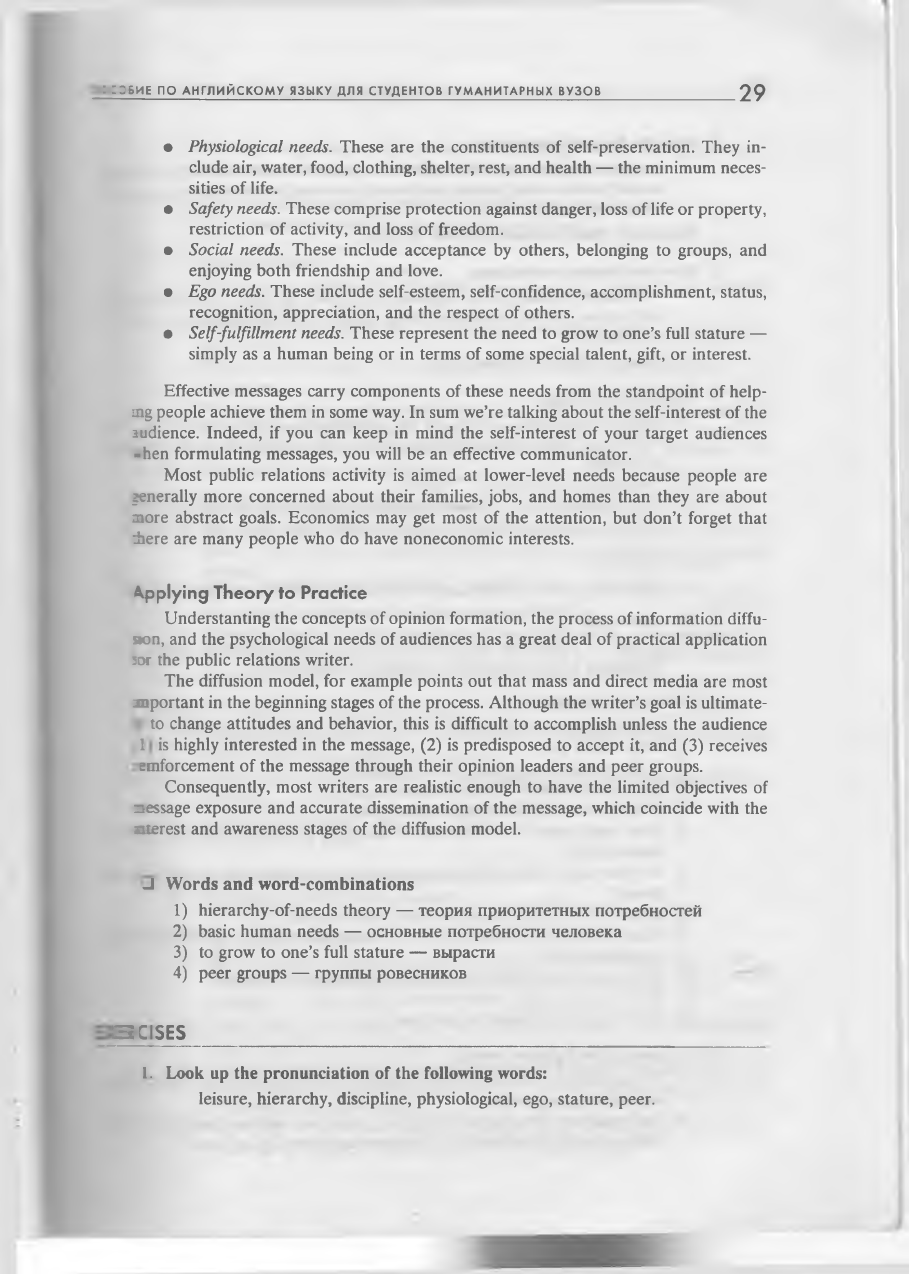
: : :
б и е
п о
а н г л и й с к о м у
я з ы к у
д л я
с т у д е н т о в
г у м а н и т а р н ы х
в у з о в
29
•
Physiological needs.
These are the constituents of self-preservation. They in
clude air, water, food, clothing, shelter, rest, and health — the minimum neces
sities of life.
•
Safety needs.
These comprise protection against danger, loss of life or property,
restriction of activity, and loss of freedom.
•
Social needs.
These include acceptance by others, belonging to groups, and
enjoying both friendship and love.
•
Ego needs.
These include self-esteem, self-confidence, accomplishment, status,
recognition, appreciation, and the respect of others.
•
Self-fulfillment needs.
These represent the need to grow to one’s full stature —
simply as a human being or in terms of some special talent, gift, or interest.
Effective messages carry components of these needs from the standpoint of help
ing people achieve them in some way. In sum we’re talking about the self-interest of the
iudience. Indeed, if you can keep in mind the self-interest of your target audiences
• hen formulating messages, you will be an effective communicator.
Most public relations activity is aimed at lower-level needs because people are
g-enerally more concerned about their families, jobs, and homes than they are about
more abstract goals. Economics may get most of the attention, but don’t forget that
± ere are many people who do have noneconomic interests.
Applying Theory to Practice
U nd erstatin g the concepts of opinion formation, the process of information diffu
sion, and the psychological needs of audiences has a great deal of practical application
гэг the public relations writer.
The diffusion model, for example points out that mass and direct media are most
important in the beginning stages of the process. Although the writer’s goal is ultimate-
to change attitudes and behavior, this is difficult to accomplish unless the audience
I is highly interested in the message, (2) is predisposed to accept it, and (3) receives
emforcement of the message through their opinion leaders and peer groups.
Consequently, most writers are realistic enough to have the limited objectives of
nessage exposure and accurate dissemination of the message, which coincide with the
m erest and awareness stages of the diffusion model.
J Words and word-combinations
1) hierarchy-of-needs theory — теория приоритетных потребностей
2) basic human needs — основные потребности человека
3) to grow to one’s full stature — вырасти
4) peer groups — группы ровесников
3 C IS E S
1
. Look up the pronunciation of the following words:
leisure, hierarchy, discipline, physiological, ego, stature, peer.
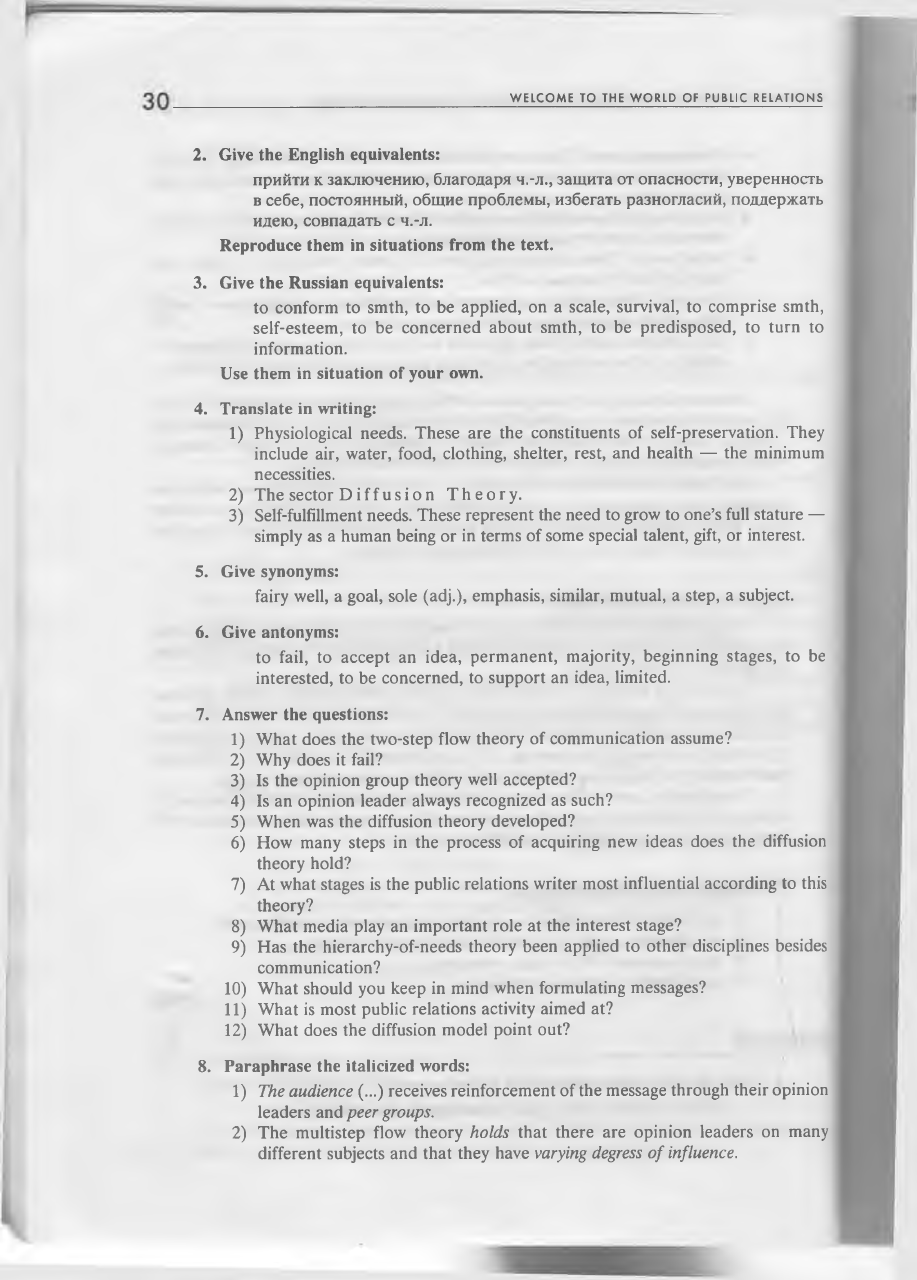
W E L C O M E T O T H E W O R L D O F P U B L I C R E L A T I O N S
2. Give the English equivalents:
прийти к заключению, благодаря ч.-л., защита от опасности, уверенность
в себе, постоянный, общие проблемы, избегать разногласий, поддержать
идею, совпадать с ч.-л.
Reproduce them in situations from the text.
3. Give the Russian equivalents:
to conform to smth, to be applied, on a scale, survival, to comprise smth,
self-esteem, to be concerned about smth, to be predisposed, to turn to
information.
Use them in situation of your own.
4. Translate in writing:
1) Physiological needs. These are the constituents of self-preservation. They
include air, water, food, clothing, shelter, rest, and health — the minimum
necessities.
2) The sector D i f f u s i o n T h e o r y .
3) Self-fulfillment needs. These represent the need to grow to one’s full stature —
simply as a human being or in terms of some special talent, gift, or interest.
5. Give synonyms:
fairy well, a goal, sole (adj.), emphasis, similar, mutual, a step, a subject.
6
. Give antonyms:
to fail, to accept an idea, perm anent, majority, beginning stages, to be
interested, to be concerned, to support an idea, limited.
7. Answer the questions:
1) What does the two-step flow theory of communication assume?
2) Why does it fail?
3) Is the opinion group theory well accepted?
4) Is an opinion leader always recognized as such?
5) When was the diffusion theory developed?
6) How many steps in the process of acquiring new ideas does the diffusion
theory hold?
7) At what stages is the public relations writer most influential according to this
theory?
8) What media play an important role at the interest stage?
9) Has the hierarchy-of-needs theory been applied to other disciplines besides
communication?
10) What should you keep in mind when formulating messages?
11) What is most public relations activity aimed at?
12) What does the diffusion model point out?
8
. Paraphrase the italicized words:
1)
The audience
(...) receives reinforcement of the message through their opinion
leaders and
peer groups.
2) The multistep flow theory
holds
that there are opinion leaders on many
different subjects and that they have
varying degress o f influence.
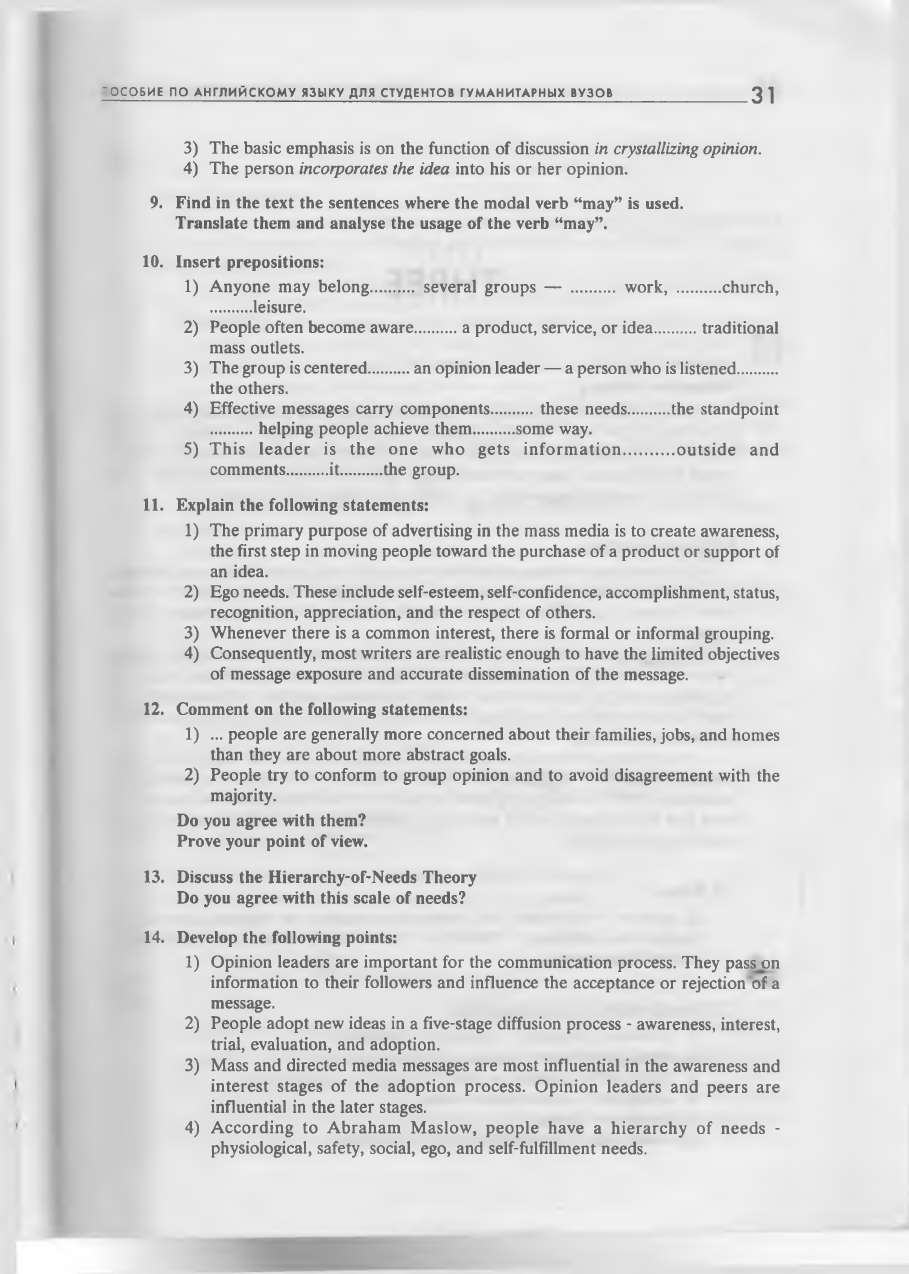
~ О С О Б И Е П О А Н Г Л И Й С К О М У Я З Ы К У Д Л Я С Т У Д Е Н Т О В Г У М А Н И Т А Р Н Ы Х В У З О В
31
3) The basic emphasis is on the function of discussion
in crystallizing opinion.
4) The person
incorporates the idea
into his or her opinion.
9. Find in the text the sentences where the modal verb “may” is used.
Translate them and analyse the usage of the verb “may”.
10. Insert prepositions:
1) Anyone may belong.......... several groups — .......... work, ..........church,
......... leisure.
2)
People often become aware......... a product, service, or idea...........traditional
mass outlets.
3)
The group is centered.........an opinion leader — a person who is listened..........
the others.
4) Effective messages carry components......... these needs........... the standpoint
......... helping people achieve them...........some way.
5) This le a d e r is the one who gets in fo rm a tio n ........... o utside and
comments......... it..........the group.
11. Explain the following statements:
1) The primary purpose of advertising in the mass media is to create awareness,
the first step in moving people toward the purchase of a product or support of
an idea.
2)
Ego needs. These include self-esteem, self-confidence, accomplishment, status,
recognition, appreciation, and the respect of others.
3)
Whenever there is a common interest, there is formal or informal grouping.
4) Consequently, most writers are realistic enough to have the limited objectives
of message exposure and accurate dissemination of the message.
12. Comment on the following statements:
1) ... people are generally more concerned about their families, jobs, and homes
than they are about more abstract goals.
2)
People try to conform to group opinion and to avoid disagreement with the
majority.
Do you agree with them?
Prove your point of view.
13. Discuss the Hierarchy-of-Needs Theory
Do you agree with this scale of needs?
14. Develop the following points:
1) Opinion leaders are important for the communication process. They pass on
information to their followers and influence the acceptance or rejection of a
message.
2)
People adopt new ideas in a five-stage diffusion process - awareness, interest,
trial, evaluation, and adoption.
3)
Mass and directed media messages are most influential in the awareness and
interest stages of the adoption process. Opinion leaders and peers are
influential in the later stages.
4) A ccording to A braham Maslow, people have a hierarchy of needs -
physiological, safety, social, ego, and self-fulfillment needs.
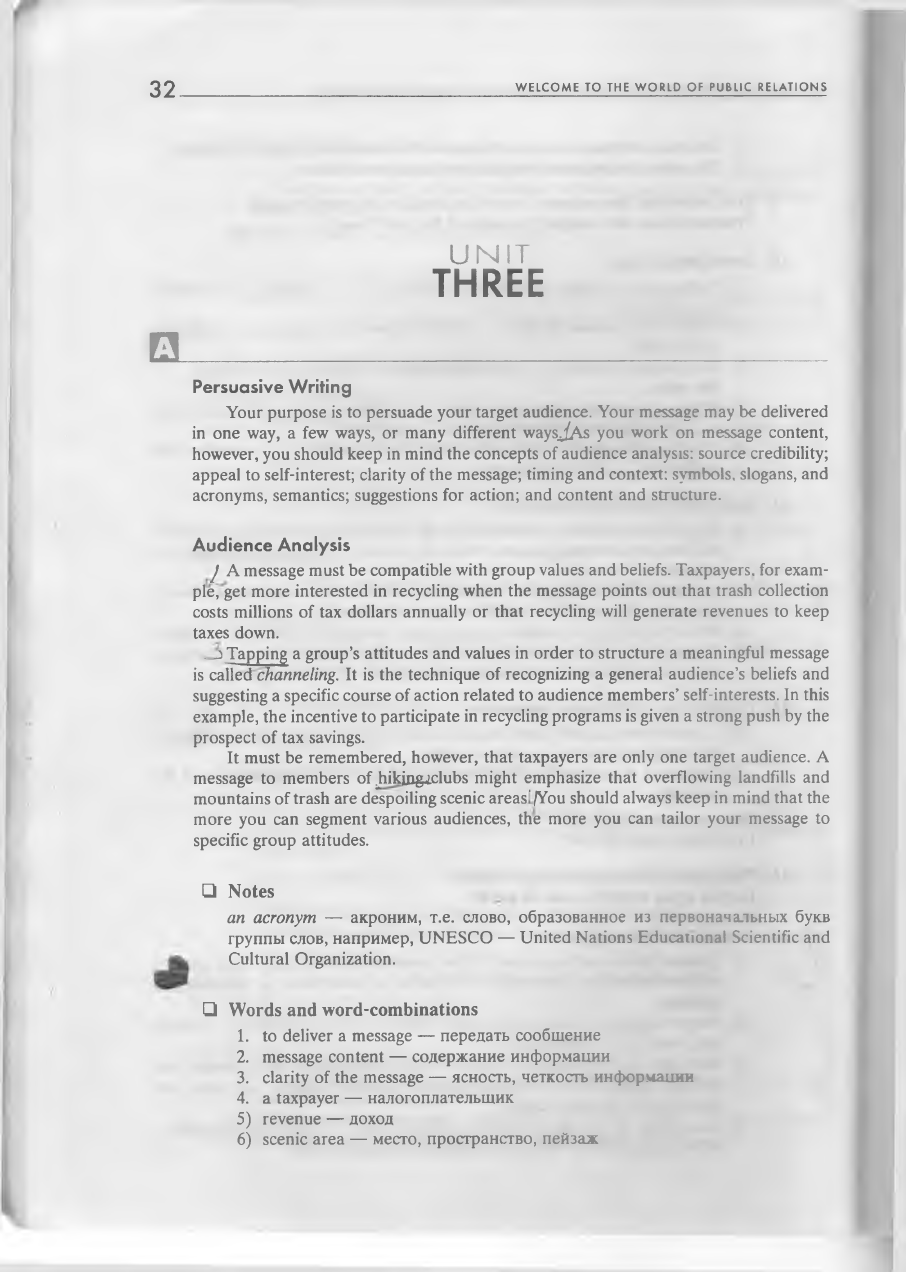
32
W E L C O M E T O T H E W O R L D O F P U B L I C R E L A T I O N S
U N I T
THREE
□
___ __________________________
Persuasive Writing
Your purpose is to persuade your target audience. Your message may be delivered
in one way, a few ways, or many different ways^fAs you work on message content,
however, you should keep in mind the concepts of audience analysis: source credibility;
appeal to self-interest; clarity of the message; timing and context: symbols, slogans, and
acronyms, semantics; suggestions for action; and content and structure.
Audience Analysis
J
A message must be compatible with group values and beliefs. Taxpayers, for exam
ple, get more interested in recycling when the message points out that trash collection
costs millions of tax dollars annually or that recycling will generate revenues to keep
taxes down.
- j Tapping a group’s attitudes and values in order to structure a meaningful message
is called
channeling.
It is the technique of recognizing a general audience’s beliefs and
suggesting a specific course of action related to audience members’ self-interests. In this
example, the incentive to participate in recycling programs is given a strong push by the
prospect of tax savings.
It must be remembered, however, that taxpayers are only one target audience. A
message to members of JiikiBgidubs might emphasize that overflowing landfills and
mountains of trash are despoiling scenic areas'/You should always keep in mind that the
more you can segment various audiences, the more you can tailor your message to
specific group attitudes.
□ Notes
an acronym
— акроним, т.е. слово, образованное из первоначальных букв
группы слов, например, UNESCO — United Nations Educational Scientific and
Cultural Organization.
□ Words and word-combinations
1. to deliver a message — передать сообщение
2. message content — содержание информации
3. clarity of the message — ясность, четкость информации
4. a taxpayer — налогоплательщик
5) revenue — доход
6) scenic area — место, пространство, пейзаж